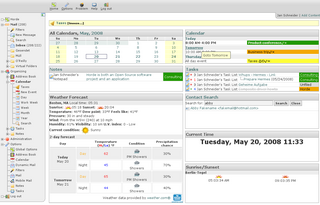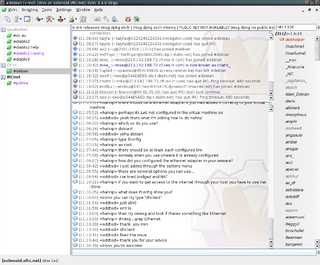
The Apache HTTP Server is a free and open-source cross-platform web server software, released under the terms of Apache License 2.0. It is developed and maintained by a community of developers under the auspices of the Apache Software Foundation.

YaST is a Linux operating system setup and configuration tool.
A BNC is a piece of software that is used to relay traffic and connections in computer networks, much like a proxy. Using a BNC allows a user to hide the original source of the user's connection, providing privacy as well as the ability to route traffic through a specific location. A BNC can also be used to hide the true target to which a user connects.
Shorewall is an open source firewall tool for Linux that builds upon the Netfilter (iptables/ipchains) system built into the Linux kernel, making it easier to manage more complex configuration schemes by providing a higher level of abstraction for describing rules using text files. Its documentation is hosted on shorewall.org, while the latest code is hosted at https://gitlab.com/shorewall/code.

FileZilla is a free and open-source, cross-platform FTP application, consisting of FileZilla Client and FileZilla Server. Clients are available for Windows, Linux, and macOS. Both server and client support FTP and FTPS, while the client can in addition connect to SFTP servers. FileZilla's source code is hosted on SourceForge.
cPanel is web hosting control panel software developed by cPanel, LLC. It provides a graphical interface (GUI) and automation tools designed to simplify the process of hosting a web site to the website owner or the "end user". It enables administration through a standard web browser using a three-tier structure. While cPanel is limited to managing a single hosting account, cPanel & WHM allows the administration of the entire server.

Horde is a free web-based groupware.

Usermin is a free and open-source webmail interface for non-root users. With it designed for deployment by system administrators on a Unix-like system the sysadmin will set limits for their customer's so that they can only access the tasks that they would be able to perform if they were logged in via SSH or at the console.

ISPConfig is an open source hosting control panel for Linux, licensed under BSD license and developed by the company ISPConfig UG. The ISPConfig project was started in autumn 2005 by Till Brehm from the German company projektfarm GmbH.
This is a comparison of notable free and open-source configuration management software, suitable for tasks like server configuration, orchestration and infrastructure as code typically performed by a system administrator.
LimeSurvey is a free and open source online statistical survey web app written in PHP using a MySQL, SQLite, PostgreSQL or MSSQL database, distributed under the GNU General Public License. Its web interface enables users to develop and publish online surveys, collect responses, review statistics, and export the resulting data to other applications.

Virtualmin is a domain hosting and website control panel which gives the ability to create and manage many domains, as well as simplify both automation and tasks. It is based on Webmin. Virtualmin is an alternative to cPanel and Plesk.

The TurnKey Linux Virtual Appliance Library is a free open-source software project which develops a range of Debian-based pre-packaged server software appliances. Turnkey appliances can be deployed as a virtual machine, in cloud computing services such as Amazon Web Services or installed in physical computers.

Shinken is an open source computer system and network monitoring software application compatible with Nagios. It watches hosts and services, gathers performance data and alerts users when error conditions occur and again when the conditions clear.

Cherokee is an open-source cross-platform web server that runs on Linux, BSD variants, Solaris, OS X, and Windows. It is a lightweight, high-performance web server/reverse proxy licensed under the GNU General Public License. Its goal is to be fast and fully functional yet still light. Major features of Cherokee include a graphical administration interface named cherokee-admin, and a modular light-weight design.

KVIrc is a graphical IRC client for Linux, Unix, Mac OS and Windows. The name is an acronym of K Visual IRC in which the K stands for a dependency to KDE, which became optional from version 2.0.0. The software is based on the Qt framework and its code is released under a modified GNU General Public License.
The following outline is provided as an overview of and topical guide to the Perl programming language:
Ansible is a suite of software tools that enables infrastructure as code. It is open-source and the suite includes software provisioning, configuration management, and application deployment functionality.

AlternC is a set of open-source Web Hosting server management software for Linux/UNIX-like systems, whose aim is to promote self hosting by individuals or small structures, and provide its users with an easy web-based interface to manage a web and mail server.

Snap is a software packaging and deployment system developed by Canonical for operating systems that use the Linux kernel and the systemd init system. The packages, called snaps, and the tool for using them, snapd, work across a range of Linux distributions and allow upstream software developers to distribute their applications directly to users. Snaps are self-contained applications running in a sandbox with mediated access to the host system. Snap was originally released for cloud applications but was later ported to also work for Internet of Things devices and desktop applications.

















